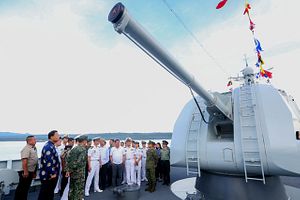This week, a flotilla of three Chinese naval ships paid a goodwill visit to the Philippines – the first such visit in seven years. Though such interactions are usually routine affairs, the significance of this one was beyond doubt. The visit is just the latest in a series of moves taken by both Manila and Beijing since President Rodrigo Duterte came to power last June to improve their relations, including in the defense realm, despite lingering disputes over the South China Sea.
From April 30 to May 2, three ships from the People’s Liberation Army Navy Task Group 150 – the Changchun (DDG-150), a guided missile destroyer; the Jinzhou (FF-G532), a guided missile frigate; and the Chaohu (890), a replenishment ship – were part of a three-day visit at Sasa Wharf in Duterte’s hometown of Davao City from April 30 to May 2.
Some Philippine officials tried to downplay the visit as being just another port call, emphasizing the fact that other countries, including the United States and Japan, were free to do so as well. Though that fact is no doubt true, it also obscures the significance of the engagement within the context of Duterte’s ongoing rapprochement with China after years of Manila bearing the brunt of Beijing’s South China Sea assertiveness.
Over the past year, we have witnessed Duterte try to embrace China as part of what some in his team have termed an “independent foreign policy,” which so far appears to mean relatively less dependence on its decades-long ally the United States and more diversification with other non-traditional partners, including Beijing and Moscow.
Despite the inherent constraints in turning such rhetoric into reality, both sides have admittedly made some progress since Duterte’s much-hyped maiden voyage to China in October, where 13 bilateral cooperation agreements were inked covering a wide range of economic and security fields, including trade and investment, agriculture, tourism, drug control, and even coast guard collaboration (See: “The Limits of Duterte’s US-China Rebalance”).
Throughout this process, Duterte has repeatedly shown how much he values a better relationship with China, emphasizing the opportunities of better bilateral ties while publicly downplaying its challenges, including Chinese actions in the South China Sea that damage Philippine interests. Indeed, just before Duterte personally visited the Chinese warships, the Philippines, which holds the annually-rotating ASEAN chairmanship this year, released a chairman’s statement following the 30th ASEAN summit that removed virtually all language critical of Beijing’s South China Sea assertiveness.
As I indicated in my piece following the episode, it illustrated how the Philippines, once the most forward-leaning Southeast Asian state calling for regional unity and global solidarity on the South China Sea question, was now willing to set that all aside for a rapprochement with Beijing that is in its narrow self-interests as defined by Duterte (See: “The Truth About Duterte’s ASEAN South China Sea Blow”).
The visit of the trio of Chinese warships is the latest step in this direction, and the newfound bonhomie was on full display during the engagement. Duterte was keen to emphasize that he himself had invited the Chinese warships to come to the Philippines, and he also requested that he be able to board them. While on board, after touring the main guns and missiles, foredeck, commanding room, and storage area, he lavished praise on the vessel, calling it hotel-like.
Not to be outdone by Duterte’s encomiums, the Chinese navy said that it had specifically chosen the Philippines as the first port call for the voyage of Task Group 150, and that it had even made a last-minute change of the destination from Manila to Davao to accommodate Duterte’s schedule. The Chinese foreign ministry, for its part, said the visit “shows the growing political mutual trust between the two countries.”
Despite the niceties and the festivities – which included games between the two navies and indigenous dances – for those closely following the evolution of Sino-Philippine relations, it is still difficult to speak about mutual trust just yet, especially when the South China Sea question shows few signs of ebbing as a flashpoint.
Amid Duterte’s ongoing rapprochement with China, the saber-rattling between Beijing and Manila has continued, with the concerns over Chinese presence at Benham Rise in March and the visit to Philippine-occupied Pagasa Island in April by Philippine Defense Secretary Delfin Lorenzana – which saw his plane repeatedly challenged by the Chinese military – being just two recent manifestations of this. Asked about Pagasa, Chinese Ambassador to the Philippines Zhao Jianhua reportedly described the challenge as “common practice,” downplayed reports of Chinese harassment of Philippine fishing vessels as “small issues,” and repeated that Philippine occupation of the islands is illegal.
All this has yet to deter Duterte from his China embrace, even though some Philippine officials insist that his flattery of Beijing masks some of the cautiousness and deliberation he displays in private after hearing from his advisers. During his visit of the Chinese warships, he repeated his suggestion that the Philippines and China could have a joint military exercise, even though his advisers rushed to clarify that it would require careful deliberation and formalization before it could actually be realized, and it carries obstacles and risks of its own (See: “Can China Patrols Help Duterte in the Philippines’ Terror War?”). But given how much ties have progressed thus far during his first year in office, one ought not to dismiss the possibility of a joint drill occurring during Duterte’s single six-year term.
































